S.F. BUDGET BLOWOUT
Topic: Science Fiction

Greetings! We are currently transmitting from our executive bunker suite just above the earth's mantle, about 29 km beneath Chicago. Our executives were forced to take evasive action after one of our core reactor's wet storage units collapsed. Like Chicago energy company ComEd (under Mothership Exelon), we have been filling vast, exposed water pools located
above our plant to max-capacity for several years, even though they were created to hold a fraction of that waste only temporarily (see: "Exelon: No plans to change its storage of nuclear waste: Science group cites risk of terror attack" Robert Manor ;
Chicago Tribune; Apr 1, 2005; pg. 1)

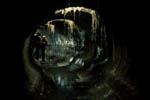
Our new base of operations happens to have a large film library, which we naturally have been accessing frequently given these circumstances. Last week we consumed two science fiction films from the 1970s. They are both ambitious productions with substantial budgets, but the similarities stop there.
Andrei Tarkovsky's
Stalker (1979) is a masterpiece of subtlety, emotion, and thoughtfullness. The premise is simple and classically science-fictional:
"'What was it? A meteorite? A visit of inhabitants of the cosmic abyss? One way or another, our small country has seen the birth of a miracle--the Zone. We immediately sent troops there. They haven't come back. Then we surrounded the Zone with police cordons...Perhaps that was the right thing to do. Though, I don't know...' -from an interview with Nobel Prize winner Professor Wallace"
In the center of this treacherous Zone (within which conventions of emotion and laws of science are warped) there is rumoured to exist a room, which grants the deepest wish of whoever enters it. "Stalker" is one of the only mean able to traverse the Zone and return safely. His latest assignment is to escort "Professor" and "Writer" to the room. This SF plot allows Tarkovsky to explore the essential meanings of humanity through philosophical dialogues of faith, doubt, reality, being, etc. This is visually empowered through experimental filmmaking techniques--parts are in a deep sepia tone, while other scenes portray the water-logged abandoned industrial zone in drab color. It was made painstakingly. In fact, a whole year was spent filming it with an experimental Kodak film only to be spoiled (perhaps purposely) by inept developers. The whole project was wasted. Though this had a profound impact on the director, the movie was ambitiously redone entirely, this time in two parts (2hrs45min total) with half the necessary budget.

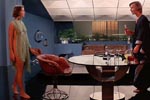
At the other side of the spectrum is
Logan's Run. Why did I even rent this--or rather, request its retrieval from our bunker's film library? It is supposed to be good or interesting at least, and perhaps a successful film could be made from its premise, or the book it was based on (
Stalker, too, is an adaption, from
Roadside Picnic by Arkady and Boris Strugatsky). This, however was not that movie. Its flashy effects today look cheap, though I don't imagine chrome-painted plastic and explosions that appear to be the result of tampered-with road flares were impressive even in the 70s. Look to
THX1138 or
Rollerball for more successful sets and effects that portray 70s visions of the future. I understand and even love that future-visions historically depict more about the era in which they were created than that which they attempt to create. But please. Farah Fawcett and poorly-crafted, unconvincing plastic

scale models for pan-over shots are not transporting me to any place of the imagination, nor are the awkward, wooden dialogues helping these trite characters.
If you even want to know, in three millenia all of society exists enclosed in a vast bubble (apparently, 2.5 feet in diameter and made of cheap plastic). Everything's pretty groovy, with silk robes, orgies, and shopping malls. However, when you turn 30 you are sacrificed in a big cult-ish spectacle called "carousel," and promised reincarnation by the giant computer that runs society (like in
Rollerball, kinda, without commentary on beaurocratic censorship/incompetence or corporate power). If you run away you (in the future they cleverly call these people "runners") you will be tracked and killed by "sandmen," a.k.a. bladerunners that suck. Our hero is a sandman who betrays the system and runs himself, with the chick, and they escape outside the bubble, find an old guy (remember, people can't age within society), bring him back to bubbleworld, blow up computer, display old man to masses, revolution and freedom ensue. FIN. THE END. OWARI. Now you needn't see it. Please rent something worthwhile, something that brings dignity to SF. Rent
Bladerunner,
THX1138,
Rollerball (with James Caan, not that lousy remake),
Brazil,
Solaris (also Tarkovsky, not that lousy remake),
Alphaville: Une Etrange Aventure de Lemmy Caution (for Godard's 60s future vision) etc. Make a movie out of ideas and talent, not lame-ass effects. Be like George Lucas in 1971, not in 2$$5.
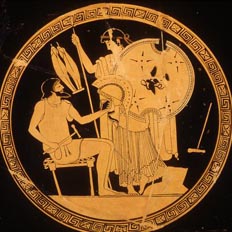 In book 18 of the Iliad Achilles' divine mother, Thetis, visits the vulcan metalsmith god Hephaistos where she receives a new suit of armor for her son and the famous shield depicting all the universe with detailed scenes of two cities, one democratic and the other in violent disarray. An interesting detail easily overlooked in this incredible chapter of Homer's epic is what is perhaps the first description of the "fembot" we have become familiar with through popular media, some serious, like Fritz Lang's powerful 1927 film Metropolis), and some kitschy, like the graphic art of Sorayama Hajime, who is sort of what Patrick Nagel would be with an airbrush and an obsession with robots.
In book 18 of the Iliad Achilles' divine mother, Thetis, visits the vulcan metalsmith god Hephaistos where she receives a new suit of armor for her son and the famous shield depicting all the universe with detailed scenes of two cities, one democratic and the other in violent disarray. An interesting detail easily overlooked in this incredible chapter of Homer's epic is what is perhaps the first description of the "fembot" we have become familiar with through popular media, some serious, like Fritz Lang's powerful 1927 film Metropolis), and some kitschy, like the graphic art of Sorayama Hajime, who is sort of what Patrick Nagel would be with an airbrush and an obsession with robots. Then with a sponge he wiped clean his forehead, and both hands,
Then with a sponge he wiped clean his forehead, and both hands, 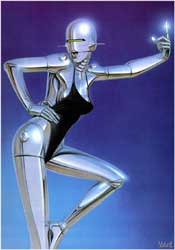 These are golden, and in appearance like living young women.
These are golden, and in appearance like living young women. 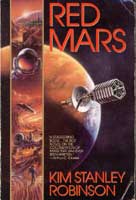

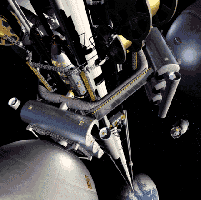

 Greetings! We are currently transmitting from our executive bunker suite just above the earth's mantle, about 29 km beneath Chicago. Our executives were forced to take evasive action after one of our core reactor's wet storage units collapsed. Like Chicago energy company ComEd (under Mothership Exelon), we have been filling vast, exposed water pools located above our plant to max-capacity for several years, even though they were created to hold a fraction of that waste only temporarily (see: "Exelon: No plans to change its storage of nuclear waste: Science group cites risk of terror attack" Robert Manor ; Chicago Tribune; Apr 1, 2005; pg. 1)
Greetings! We are currently transmitting from our executive bunker suite just above the earth's mantle, about 29 km beneath Chicago. Our executives were forced to take evasive action after one of our core reactor's wet storage units collapsed. Like Chicago energy company ComEd (under Mothership Exelon), we have been filling vast, exposed water pools located above our plant to max-capacity for several years, even though they were created to hold a fraction of that waste only temporarily (see: "Exelon: No plans to change its storage of nuclear waste: Science group cites risk of terror attack" Robert Manor ; Chicago Tribune; Apr 1, 2005; pg. 1)
 Our new base of operations happens to have a large film library, which we naturally have been accessing frequently given these circumstances. Last week we consumed two science fiction films from the 1970s. They are both ambitious productions with substantial budgets, but the similarities stop there.
Our new base of operations happens to have a large film library, which we naturally have been accessing frequently given these circumstances. Last week we consumed two science fiction films from the 1970s. They are both ambitious productions with substantial budgets, but the similarities stop there. 
 At the other side of the spectrum is Logan's Run. Why did I even rent this--or rather, request its retrieval from our bunker's film library? It is supposed to be good or interesting at least, and perhaps a successful film could be made from its premise, or the book it was based on (Stalker, too, is an adaption, from Roadside Picnic by Arkady and Boris Strugatsky). This, however was not that movie. Its flashy effects today look cheap, though I don't imagine chrome-painted plastic and explosions that appear to be the result of tampered-with road flares were impressive even in the 70s. Look to THX1138 or Rollerball for more successful sets and effects that portray 70s visions of the future. I understand and even love that future-visions historically depict more about the era in which they were created than that which they attempt to create. But please. Farah Fawcett and poorly-crafted, unconvincing plastic
At the other side of the spectrum is Logan's Run. Why did I even rent this--or rather, request its retrieval from our bunker's film library? It is supposed to be good or interesting at least, and perhaps a successful film could be made from its premise, or the book it was based on (Stalker, too, is an adaption, from Roadside Picnic by Arkady and Boris Strugatsky). This, however was not that movie. Its flashy effects today look cheap, though I don't imagine chrome-painted plastic and explosions that appear to be the result of tampered-with road flares were impressive even in the 70s. Look to THX1138 or Rollerball for more successful sets and effects that portray 70s visions of the future. I understand and even love that future-visions historically depict more about the era in which they were created than that which they attempt to create. But please. Farah Fawcett and poorly-crafted, unconvincing plastic  scale models for pan-over shots are not transporting me to any place of the imagination, nor are the awkward, wooden dialogues helping these trite characters.
scale models for pan-over shots are not transporting me to any place of the imagination, nor are the awkward, wooden dialogues helping these trite characters.